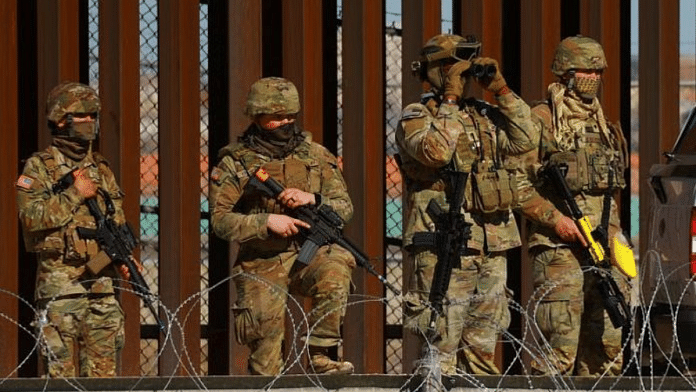Thank you dear subscribers, we are overwhelmed with your response.
Your Turn is a unique section from ThePrint featuring points of view from its subscribers. If you are a subscriber, have a point of view, please send it to us. If not, do subscribe here: https://theprint.in/subscribe/
For over seven decades, the United States has enjoyed an uncontested reputation as the world’s foremost military power. With unmatched defence spending, technological superiority, and a sprawling global footprint of bases, the American military projects force and influence like no other.
Following the U.S.’s most recent Operation Midnight Hammer against Iran, a question looms larger with every intervention – including this one: Can the most powerful military in the world still win a war?
The answer, as history increasingly suggests, is far more complex than raw firepower or budgetary might.
Tactical Success, Strategic Failure
Since World War II, America’s military record reveals a pattern of tactical victories and strategic ambiguity. Korea ended in stalemate, Vietnam in retreat, Somalia in withdrawal, Iraq in instability, Libya in collapse, and Afghanistan in a swift Taliban resurgence. Even “successful” campaigns like the 1991 Gulf War left behind fragile gains and enduring instability.
That is not to say the U.S. cannot win battles. It can, and often does, with extraordinary precision. But winning battles is not the same as winning wars. War is a political act. Its end goal is to establish a desired political outcome. Here is where America stumbles: unmatched military dominance paired with unclear or shifting strategic objectives.
Power Is not the Problem
Militarily, no one comes close. The U.S. defence budget exceeds $800 billion, greater than the next 10 countries combined. It possesses cutting-edge drones, aircraft carriers, nuclear submarines, stealth bombers, and cyberwarfare units. It has over 750 overseas military installations across 80 countries. The American military can deploy anywhere, anytime, and with overwhelming force.
This is not a PR illusion. The capacity is real.
But that capacity has not translated into long-term geopolitical success. The U.S. is trapped in a paradox: the more it relies on military tools to impose political will, the more it finds itself overextended, under rewarded, and often mired in instability.
The Asymmetry Trap
From Vietnam to Afghanistan, the U.S. has struggled against unconventional foes: insurgents, militants, ideologues, who do not fight for territory, but for sovereignty and belief. These enemies do not need to win; they just need to survive. They blend into civilian populations, strike unpredictably, and rebuild faster than the U.S. can respond.
In such wars, superior firepower matters less. Counterinsurgency, troop surges, and nation-building efforts often collapse under local resistance and political contradictions. Victory, in the traditional sense, becomes a mirage.
Hegemony’s High Cost
Part of the burden lies in America’s self-imposed role as global enforcer. It does not merely secure its borders; it stabilizes fragile states, polices shipping lanes, and supports allies from Eastern Europe to the Indo-Pacific.
Maintaining this role has costs – diplomatic, financial, and human. Nearly 750 military bases may project dominance, but they do not guarantee security. Cyberattacks, homegrown extremism, and asymmetric threats continue to rise. If bases were the metric for safety, America should be invulnerable. It is not.
Meanwhile, rivals like China and Russia often spend less but achieve targeted objectives, be it territorial gains, regime support, or strategic influence.
Rethinking the Narrative
Part of the dissonance comes from how power is perceived and applied. American culture, media, and Hollywood have long portrayed U.S. military dominance as synonymous with righteousness and invincibility. But in recent years, this image has come under strain.
Images of helicopters evacuating Kabul echoed Saigon. Wars waged under moral pretexts have ended in ethical and strategic confusion. At home, the public grows weary. Veterans return disillusioned. Policymakers struggle to explain what was truly achieved.
What Does Winning Even Mean?
The deeper issue may be definitional. The U.S. military is built to destroy enemies, not rebuild societies. But modern warfare requires both: combat capacity and political vision.
Success today demands post-conflict governance, social repair, and local legitimacy. These are political and diplomatic tasks. Increasingly, the U.S. seems either unprepared or unwilling to commit to the slow, imperfect work of statecraft.
Meanwhile, power is becoming multidimensional. China combines infrastructure, diplomacy, debt, and digital tools with military buildup. Influence today spreads through trade routes, fibre optics, and policy forums, not just troop deployments.
Power Needs Purpose
So, can the most powerful military still win a war? Yes – if we define winning narrowly: defeating enemies, toppling regimes, enforcing airspace. But if we define it as securing long-term peace or advancing national interests sustainably, then the record is troubling.
America’s military might remain unmatched. But dominance without clarity is a blunt instrument. Power without purpose does not yield peace – it extends conflict.
As the U.S. navigates future flashpoints, in the Indo-Pacific, the Middle East, or Eastern Europe, its true challenge may not be how to win the next war, but how to end it on its own terms. That is the real test of power.
These pieces are being published as they have been received – they have not been edited/fact-checked by ThePrint.


